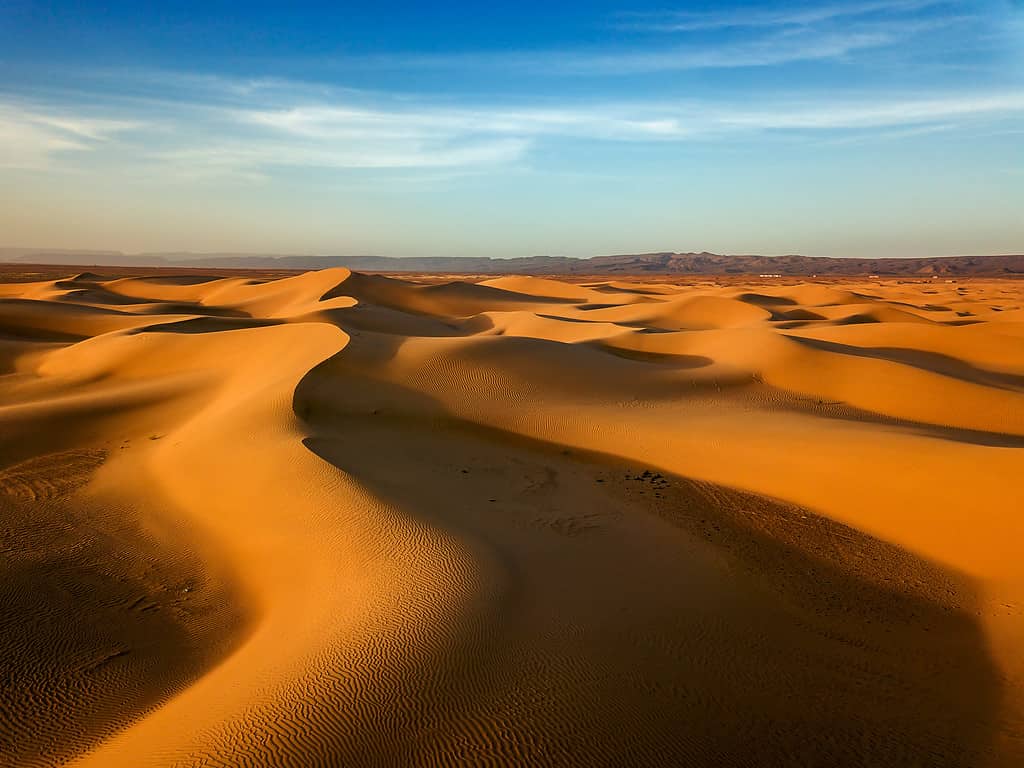As you might guess, the Sahara desert gets very little rainfall. Each year, the entire desert receives an average of 3 inches. For comparison, the global average rainfall is 31 inches per year, so 3 inches is far below average.
The definition of a desert is somewhere that gets less than 10 inches of rain a year. So, even compared to other deserts, the Sahara gets very little rainfall.
Of course, this rainfall isn’t distributed evenly across the whole desert, either.
Distribution of Sahara Desert Rainfall

The amount of Sahara Desert rain varies by location; the southern portion receives slightly more than other areas.
©Michal Balada/Shutterstock.com
Rainfall varies considerably within the Sahara desert. Some places receive as little as 0.2 inches annually, especially in the central and northern portions. However, areas on the southern end of the Sahara desert get a bit more rainfall – often around 5 inches.
The southern portion receives most of its rainfall in the summer months when the Intertropical Convergence Zone moves north. That’s also why it receives more rainfall than the rest of the desert.
On the other hand, the northern Sahara receives very little rainfall in the winter months.
Often, the rain the Sahara gets isn’t distributed evenly across several days, either. Instead, it’s mostly in the form of intense thunderstorms. These cause flash floods across the valley.
Rainfall Expectations

When it does rain, the Sahara tends to flood.
©Mik122/iStock via Getty Images
These Sahara rainfall estimates don’t hold everywhere, though. In some cases, certain areas of the desert get less or more rain.
The mountains in the Sahara tend to get more rain due to their higher elevation. They might even receive snowfall if precipitation falls at night, as the air often gets below freezing. The Hoggar and Tibesti Massifs both fall into this category, as well as the more minor mountains in the region.
The western edges of the desert tend to experience more fog and humidity. The Canary Current is the cause of this. Despite being more humid, these areas tend to get less rainfall. The air is cooler, leading to less precipitation.
Is The Sahara Desert Getting More Rain?
The earth’s climate is changing all the time. The Sahara wasn’t always a desert, and it likely hasn’t been a desert the whole time people were around, either. Instead, the changing global climate caused rain to start missing this area, which made it a desert.
However, there is a significant chance that the Sahara desert won’t stay a desert forever. Satellite imagery shows part of the Sahara desert becoming greener over the past few decades. Likely, this is because the area slowly receives more and more rainfall.
Of course, we don’t know anything for certain yet. Making a desert into even a semiarid region naturally takes hundreds of years. Short-term fluctuations are also possible. Just because rainfall has increased in the last few years doesn’t mean it will stay that way. The Sahara desert has a very erratic climate, after all.
The photo featured at the top of this post is © mazzo1982/iStock via Getty Images
Thank you for reading! Have some feedback for us? Contact the AZ Animals editorial team.







